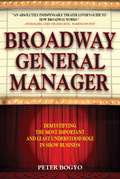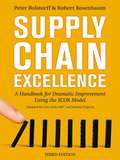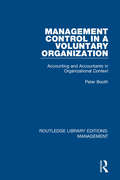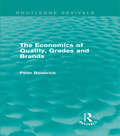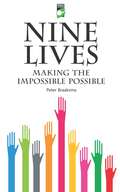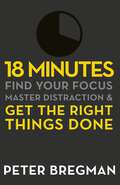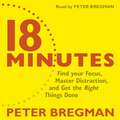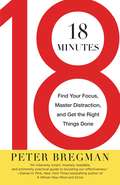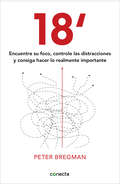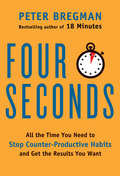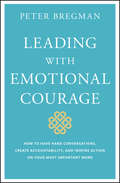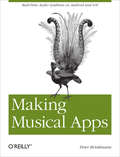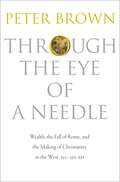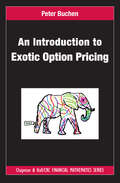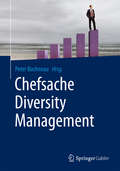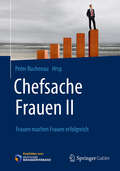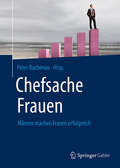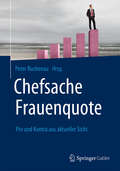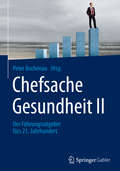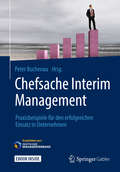- Table View
- List View
Broadway General Manager: Demystifying the Most Important and Least Understood Role in Show Business
by Peter Bogyo“An absolutely indispensable theater lover’s guide to how Broadway works.” —Peter Marks, chief theater critic, Washington Post“Highly recommended for those considering theater as a career and for those who love theater and want to know more about what goes on before the curtain goes up and after.” —Library JournalBroadway General Manager is a fascinating, insightful, and entertaining glimpse into the normally closed world of theatrical general management. Penned by veteran Broadway insider Peter Bogyo, readers will gain an appreciation and understanding of what the business half of show business is all about. For the first time ever, gain backstage access to the fast-paced and glamorous world of Broadway. Broadway General Manager is an invaluable resource that examines actual production and operating budgets for a Broadway show and shares contracts for award-winning actors, directors, and designers, all of which are analyzed extensively. Also included are in-depth discussions on such topics as:How to get started as a general manager Negotiating contracts How the producing entity functions Programming the box office The issues related to hiring employees Binding insurance Financial overview Maintaining the run of a show What to do when sales start to slump Closing a show And much more Laced with humorous insights and personal anecdotes, Broadway General Manager will delight both the average theater lover as well as individuals with a serious interest in commercial arts management.
Supply Chain Excellence: A Handbook for Dramatic Improvement Using the SCOR Model
by Peter Bolstorff Robert RosenbaumThe Supply Chain Council (SCC) is a nonprofit organization dedicated to developing best practices in supply chain management. Now in a newly revised, second edition, Supply Chain Excellence is the first and only book on the DCOR, CCOR, and SCOR Models. It gives professionals implementing new supply chain projects a clear, step-by-step guide to adopting the accepted and proven methodologies developed by the SCC. This book shows readers how they can: * align strategy, material, workflow, and information * conduct the proper competitive analysis to define business opportunity * establish the metrics that will determine the project’s level of success * gain internal support by educating employees and executives Complete with new case studies, a Value Chain Excellence project roadmap, and the addition of the DCOR and CCOR process frameworks, the second edition of Supply Chain Excellence gives readers all the practical tools they need, whether they’re trying to improve the performance of an existing supply chain system or implement a new one.
Management Control in a Voluntary Organization: Accounting and Accountants in Organizational Context (Routledge Library Editions: Management #16)
by Peter BoothThis book, originally published in 1995, is concerned with the study of accounting within its organizational and social context. The author analyses accounting as having potential effects at both an ideological level and at an occupational level. Empirically, it is explored within the context of voluntary organizations as theoretically interesting extreme cases, where the conditions for accounting to be significant should be most open to question. This title will be of interest to students of business studies and management.
The Economics of Quality, Grades and Brands (Routledge Revivals)
by Peter BowbrickVirtually every decision to produce, buy or sell is influenced by quality, yet until this book was first published in 1992, there had been very little attempt to produce a comprehensive and practical theory for this. Here, Peter Bowbrick brings together different traditions of quality analysis from economics, marketing economics and marketing itself to identify the limitations of the different traditions of quality economics and some approaches to its analysis. Beginning with a definition of the subject and the concepts involved, this comprehensive title will be of particular value to students of Economics, Marketing and Business Studies.
Social Control in Industrial Organisations: Industrial Relations and Industrial Sociology: A Strategic and Occupational Study of British Steelmaking (Routledge Library Editions: Industrial Economics #31)
by Peter BowenBased on an industrial relations case study conducted in a British Steel plant in the north east coast iron and steel industry, this book, first published in 1976, is an account of the application of sociological concepts and ideas to the process of social relations between employer and employee, and between all types of workers in industrial organisations.
Nine Lives
by Peter Braaksma"You can cut the flower, but you cannot stop the coming of spring." Malalai Joya, the young member of the Afghan parliament, refuses to let injustice go unchallenged. Her words reflect the irrepressible attitudes and actions of all the women and men who tell their stories here.As with all the titles in New Internationalist's World Changing imprint, Nine Lives sees opportunity in the midst of adversity and presents the life stories of people who have been confronted with seemingly insurmountable obstacles, opposition, and oppression.Whether it is human rights activist Harry Wu, who spent nineteen years in Chinese labor camps, or Nobel Laureate and President of Costa Rica Oscar Arias Sánchez, each of the nine voices in this collection has confronted an urgent and inescapable need to dig deep, either to rescue themselves or to forge a fresh way forward for others.To understand the key stories behind the headlines, Peter Braaksma believes that it is essential to feel the personal, intimate experience of people working on the frontline of human rights and humanitarian issues; that the stories, uninterrupted and unpolished, must speak for themselves.Reading like nine mini-novels, the nine remarkable stories belong to Bassam Aramin (Palestinian National Authority), Monireh Baradaran (Iran), Youk Chhang (Cambodia), Sompop Jantraka (Thailand), Malalai Joya (Afghanistan), Chaeli Mycroft (South Africa), Oscar Arias Sánchez (Costa Rica), and Harry Wu (China).Peter Braaksma has worked as an editor, communications advisor, and journalist in the Netherlands and the United Kingdom.
18 Minutes: Find Your Focus, Master Distraction and Get the Right Things Done
by Peter BregmanThe most important business/self-help book since EMOTIONAL INTELLIGENCE and THE ONE-MINUTE MANAGER.How often do you get to the end of another long and frantic day and wonder why so many important things didn't get finished? We've never worked so hard and felt so unproductive and unfulfilled. 18 MINUTES takes this challenge and turns it on its head. Peter Bregman, top HARVARD BUSINESS REVIEW columnist and global management consultant, shatters the myth of getting it all done by offering a clear and simple plan for getting the right things done. He shows how the best way to fight distracting interruptions is to create productive ones ourselves, a practice that can be easily implemented in 18 minutes a day. The result is a simple yet comprehensive approach to managing your life a year, a day, and a moment at a time so that your life moves forward the way you want and at the pace you want.
18 Minutes: Find Your Focus, Master Distraction and Get the Right Things Done
by Peter BregmanHow often do you get to the end of another long and frantic day and wonder why so many important things didn't get finished? We've never worked so hard and felt so unproductive and unfulfilled. 18 MINUTES takes this challenge and turns it on its head. Peter Bregman, top HARVARD BUSINESS REVIEW columnist and global management consultant, shatters the myth of getting it all done by offering a clear and simple plan for getting the right things done. He shows how the best way to fight distracting interruptions is to create productive ones ourselves, a practice that can be easily implemented in 18 minutes a day. The result is a simple yet comprehensive approach to managing your life a year, a day, and a moment at a time so that your life moves forward the way you want and at the pace you want.Written and read by Peter Bregman(p) 2011 Hachette Audio
18 Minutes: Find Your Focus, Master Distraction, and Get the Right Things Done
by Peter BregmanBased upon his weekly Harvard Business Review columns (which is one of the most popular columns on HBR.com, receiving hundreds of thousands of unique page views a month), 18 MINUTES clearly shows how busy people can cut through all the daily clutter and distractions and find a way to focus on those key items which are truly the top priorities in our lives. Bregman works from the premise that the best way to combat constant and distracting interruptions is to create productive distractions of one's own. Based upon a series of short bite-sized chapters, his approach allows us to safely navigate through the constant chatter of emails, text messages, phone calls, and endless meetings that prevent us from focusing our time on those things that are truly important to us. Mixing first-person insights along with unique case studies, Bregman sprinkles his charming book with pathways which help guide us -- pathways that can get us on the right trail in 18 minutes or less.
18 minutos: Encuentre su foco, controle las distracciones y consiga hacer lo importante
by Peter BregmanEl método para lograr concentrarse en aquello que es realmente prioritario para usted. ¿No siente con frecuencia que llega al final de su jornada agotado, pero sin haber avanzado en ninguna de las tareas que se había fijado como prioridades en su trabajo o en su vida personal? 18 minutos plantea la solución que le permitirá eliminar las constantes distracciones del día a día y concentrarse en aquellas actividades que le resultan realmente importantes. El autor parte de la premisa de que la mejor fórmula para luchar contra las constantes interrupciones es crear nuestras propias distracciones productivas. Estructurado en breves capítulos, el libro enseña una estrategia que nos permitirá navegar sin naufragar por el continuo flujo de correos electrónicos, mensajes, llamadas y reuniones que nos impiden dedicar nuestro tiempo a todo aquello que es realmente importante para nosotros... con invertir tan solo 18 minutos cada día. Reseñas:«18 minutos es una guía verdaderamente inteligente, asequible y, sobre todo, muy práctica, y que contribuirá a potenciar su eficacia y a incrementar su satisfacción. Yo lo he comprobado en mi propio trabajo. Usted también lo notará.»Daniel H. Pink, autor del best seller Una nueva mente «Sentir que mantenemos el control sobre cómo empleamos nuestro tiempo es un factor clave para alcanzar la felicidad. En este libro ameno y práctico, Peter Bregman nos muestra cómo disponer de tiempo suficiente para hacer las cosas que realmente nos importan, de tal forma que nuestra vida se convierta en un reflejo de nuestros valores y prioridades.»Gretchen Rubin, autora del best seller Objetivo: felicidad «Lea este libro. La sabiduría de su autor, su humildad y su capacidad para narrar impregnan cada página. 18 minutos es la mejor combinación entre un libro de empresa y uno de superación personal.»Robert Sutton, profesor de la Universidad de Stanford y autor de Buen jefe, mal jefe
Four Seconds
by Peter BregmanAll too often our best efforts to accomplish the things we want most--to do our jobs well, to make meaningful contributions at home and at work, to have satisfying relationships with loved ones, friends, neighbors, and coworkers--are built on bad habits that sabotage us. We feel overwhelmed by our increasingly large to-do list, so we automatically multitask to get more done--and end up more stressed and more overloaded. We say something with the hopes of impressing the other person, but instead of end them--then spend days trying to repair the damage. We give what we think is a pep talk to our team-- but they walk away demotivated.How can we be most effective and productive in a world that moves too fast and demands so much of us?In Four Seconds, Peter Bregman shows that the answer is to pause for as few as four seconds--the length of a deep breath--to replace bad habits and reactions with more productive behaviors. In his trademark style of blending personal anecdotes with practical advice, Bregman reveals some of our most common counter-productive tendencies and describes counter-intuitive strategies for acting more intentionally, including: Why setting goals can actually harm your performance How to use strategic disengagement to recover focus and willpower Why listening--not arguing--is the best strategy for changing someone's mind How taking responsibility for someone else's failure can actually help you succeedDrawn from Bregman's hugely popular Harvard Business Review blog, this engaging and wise book provides simple solutions to create the results you want without the stress.
Leading With Emotional Courage: How to Have Hard Conversations, Create Accountability, And Inspire Action On Your Most Important Work
by Peter BregmanThe Wall Street Journal bestselling author of 18 Minutes unlocks the secrets of highly successful leaders and pinpoints the missing ingredient that makes all the difference You have the opportunity to lead: to show up with confidence, connected to others, and committed to a purpose in a way that inspires others to follow. Maybe it’s in your workplace, or in your relationships, or simply in your own life. But great leadership—leadership that aligns teams, inspires action, and achieves results—is hard. And what makes it hard isn’t theoretical, it’s practical. It’s not about knowing what to say or do. It’s about whether you’re willing to experience the discomfort, risk, and uncertainty of saying or doing it. In other words, the most critical challenge of leadership is emotional courage. If you are willing to feel everything, you can do anything. Leading with Emotional Courage, based on the author’s popular blogs for Harvard Business Review, provides practical, real-world advice for building your emotional courage muscle. Each short, easy to read chapter details a distinct step in this emotional “workout,” giving you grounded advice for handling the difficult situations without sacrificing professional ground. By building the courage to say the necessary but difficult things, you become a stronger leader and leave the “should’ves” behind. Theoretically, leadership is straightforward, but how many people actually lead? The gap between theory and practice is huge. Emotional courage is what bridges that gap. It’s what sets great leaders apart from the rest. It gets results. It cuts through the distractions, the noise, and the politics to solve problems and get things done. This book is packed with actionable steps you can take to start building these skills now. Have the courage to speak up when others remain silent Be stable and grounded in the face of uncertainty Respond productively to opposition without getting distracted Weather others’ anger without shutting down or getting defensive Leading with Emotional Courage coaches you to build your emotional courage, exercise it effectively, and create an environment in which people around you take accountability to get hard things done.
Making Musical Apps: Real-time audio synthesis on Android and iOS
by Peter BrinkmannWant to turn your mobile device into a musical instrument? Or equip your game with interactive audio, rather than canned samples? You can do it with Pure Data (Pd), an open source visual programming environment that lets you manipulate digital audio in real time. This concise book shows you how to use Pd—with help from the libpd library—as an easily embeddable and widely portable sound engine.Whether you’re an audio developer looking to create musical apps with sophisticated audio capabilities, or an application developer ready to enhance mobile games with real-time procedural audio, Making Musical Apps introduces you to Pd and libpd, and provides hands-on instructions for creating musical apps for Android and iOS.Get a crash course in Pd, and discover how to generate and control soundsLearn how to create and deploy algorithmic compositions that react to a user’s activity and environmentUse Java or Objective-C to integrate Pd and libpd into mobile appsLearn the steps necessary to build libpd-based apps for Android and iOS
Through the Eye of a Needle: Wealth, the Fall of Rome, and the Making of Christianity in the West, 350-550 AD
by Peter BrownA sweeping intellectual history of the role of wealth in the church in the last days of the Roman EmpireJesus taught his followers that it is easier for a camel to go through the eye of a needle than for a rich man to enter heaven. Yet by the fall of Rome, the church was becoming rich beyond measure. Through the Eye of a Needle is a sweeping intellectual and social history of the vexing problem of wealth in Christianity in the waning days of the Roman Empire, written by the world's foremost scholar of late antiquity.Peter Brown examines the rise of the church through the lens of money and the challenges it posed to an institution that espoused the virtue of poverty and called avarice the root of all evil. Drawing on the writings of major Christian thinkers such as Augustine, Ambrose, and Jerome, Brown examines the controversies and changing attitudes toward money caused by the influx of new wealth into church coffers, and describes the spectacular acts of divestment by rich donors and their growing influence in an empire beset with crisis. He shows how the use of wealth for the care of the poor competed with older forms of philanthropy deeply rooted in the Roman world, and sheds light on the ordinary people who gave away their money in hopes of treasure in heaven.Through the Eye of a Needle challenges the widely held notion that Christianity's growing wealth sapped Rome of its ability to resist the barbarian invasions, and offers a fresh perspective on the social history of the church in late antiquity.
An Introduction to Exotic Option Pricing (Chapman And Hall/crc Financial Mathematics Ser.)
by Peter BuchenIn an easy-to-understand, nontechnical yet mathematically elegant manner, An Introduction to Exotic Option Pricing shows how to price exotic options, including complex ones, without performing complicated integrations or formally solving partial differential equations (PDEs). The author incorporates much of his own unpublished work, including ideas
Chefsache Arbeitsrecht I: Individual-arbeitsrecht - Leicht Erklärt (Chefsache)
by Peter Buchenau Urs Peter JanetzDas Chefsache-Buch unterstützt Arbeitgeber und leitende Angestellte mit wichtigen Informationen zu allen Themen des Individualarbeitsrechts. Weit verbreitet ist die Ansicht, dass „der Arbeitnehmer doch sowieso immer gewinnt“ und dass man als Arbeitgeber „ohnehin keine Chance vor Gericht hat“ hat. Doch das muss nicht sein – wenn man sich als Arbeitgeber mit der Thematik rechtzeitig beschäftigt und mit Augenmaß und Wertschätzung an die Materie herangeht. Dafür ist dieses Buch ein hilfreicher Einstieg. Der Text verzichtet komplett auf juristische Fachsprache. Stattdessen vermittelt der Autor die Materie sehr kompakt, verständlich und humorvoll. Zahlreiche Beispielfälle und Info-Boxen verdeutlichen die Zusammenhänge. So werden die Leser schnell für die arbeitsrechtlichen Knackpunkte und Stolpersteine sensibilisiert. Im Anhang werden Mustertexte für einen Arbeitsvertrag, einen Aufhebungsvertrag und eine Abmahnung zur Verfügung gestellt.
Chefsache Digitale Nachhaltigkeit: Herausforderungen erkennen – Lösungen umsetzen (Chefsache)
by Peter BuchenauDieses Fachbuch wurde von sieben Interim Managern, Consultants und erfahrenen Führungskräften geschrieben. Aus vielfältigen Perspektiven wird das Thema Nachhaltigkeit im Rahmen der digitalen Transformation in mittelständischen Unternehmen und internationalen Konzernen betrachtet. Der Megatrend Nachhaltigkeit wird für Fachkräfte, Geschäftsführer und Vorstände praxisorientiert anhand von konkreten Projekten dargestellt. Es wird aufgezeigt, welche Chancen sich im Wettbewerb für Unternehmen und die Wirtschaft ergeben. Die praxiserfahrenen Verfasser zeichnen ein realistisches Bild, wie Geschäftsmodelle, Prozesse und Organisationen im Rahmen der Digitalisierung optimiert, weiterentwickelt und nachhaltig wertschöpfend gestaltet werden können. Dabei werden konkrete Handlungsempfehlungen vorgestellt.
Chefsache Diversity Management
by Peter BuchenauDas Buch stellt die aktuellen Herausforderungen von Diversity bzw. Vielfaltsmanagement vor. Gerade die Personalabteilungen von Unternehmen stellt Diversity vor große Anforderungen, da es meist im Sinne von ,,soziale Vielfalt konstruktiv nutzen" verwendet wird. Diversity Management toleriert nicht nur die individuelle Verschiedenheit der Mitarbeiter und Mitarbeiterinnen, sondern hebt diese im Sinne einer positiven Wertschätzung besonders hervor und versucht, sie für den Unternehmenserfolg nutzbar zu machen. Die Autoren zeigen in vielen Praxisbeispielen auf, was Unternehmen tun können, um Diversity Management werteorientiert und nachhaltig sicherzustellen.
Chefsache Erfolg
by Peter BuchenauDieses Fachbuch beschreibt mit der Performer Methode einen systematischen Weg zur Leistungssteigerung für Manager. In neun Kapiteln werden die Methoden praxisnah und anschaulich vorgestellt: P=Purpose, E=Empowerment, R=Relationship, F= Flexibility, O= Optimism, R= Respect, M= Magnetism, E= Energy, R= Repetition. Die Autoren, die Top-Berater und jeweils Experten in ihrem Fachgebiet sind, schildern eigene Erlebnisse und begründen, wie wichtig es ist, sich jeweils dem einzelnen Baustein zu widmen. Den größten Erfolg bringt das Zusammenspiel der einzelnen Bausteine.
Chefsache Frauen II: Frauen machen Frauen erfolgreich
by Peter BuchenauDieser Band aus der beliebten Reihe "Chefsache" schildert in origineller und innovativer Weise die Erfolgsfaktoren weiblicher F#65533;hrung, diesmal von Frauen f#65533;r Frauen. Daher berichten Business-Frauen in unterschiedlichsten Funktionen, was aus der Sicht einer Frau die Erfolgsfaktoren f#65533;r eine Karriere sind. So wird das g#65533;ngige Klischee "Frauen lassen sich von Frauen trainieren, M#65533;nner von M#65533;nnern" kritisch gepr#65533;ft und es er#65533;ffnen sich neue Perspektiven.
Chefsache Frauen: Männer machen Frauen erfolgreich
by Peter BuchenauDieser Band aus der beliebten Reihe "Chefsache" schildert in origineller und innovativer Weise die Erfolgsfaktoren weiblicher Führung. Die durchweg männlichen Beitragsautoren beschreiben, was aus ihrer Sicht Frauen in Führungspositionen erfolgreich macht. So wird das gängige Klischee "Frauen lassen sich von Frauen trainieren, Männer von Männern" auf den Kopf gestellt und neue Perspektiven eröffnen sich. Leserinnen erhalten Karrieretipps sozusagen von Mann zu Frau und werden von der männlichen Sicht auf Frauen in Führungspositionen überrascht sein.
Chefsache Frauenquote: Pro und Kontra aus aktueller Sicht
by Peter BuchenauDas Buch zeigt in Pro- und Kontra-Diskussionen Wege und Mittel zur Umsetzung der Frauenquote auf. Die 30-prozentige Quote wird für Großunternehmen und den Öffentlichen Dienst sukzessive eingeführt. Das Gesetz soll Frauen und Männern gleiche Teilhabe an Führungspositionen in Wirtschaft und Verwaltung sichern. Es verpflichtet Arbeitgeber, das jeweils unterrepräsentierte Geschlecht - in der Regel Frauen - stärker zu berücksichtigen. Die Autoren geben praktische Hinweise und zeigen Alternativen auf.
Chefsache Gesundheit I: Der Führungsratgeber fürs 21. Jahrhundert
by Peter BuchenauDas Fachbuch beschäftigt sich mit der Gesundheit von Mitarbeitern in Unternehmen. Gesundheit wird zur Chefsache und zum Wirtschaftsfaktor in Unternehmen. Der demografische Wandel und ein damit verbundener Mangel an leistungsfähigen Führungs- und Fachkräften, der stete Druck, sich an einem globalisierten Markt zu beweisen, die immer komplexer werdenden Prozesse der internen Administration – all dies stellt Unternehmen und Mitarbeiter vor enorme Herausforderungen. Umso wichtiger wird es in diesem Zusammenhang, die wertvolle Ressource Mensch zu schützen und dessen Arbeitskraft zu erhalten. 15 Coaches, Berater und Trainer beschreiben bezogen auf ihr jeweiliges Fachgebiet, welchen Einfluss der Faktor Gesundheit künftig auf Unternehmen haben wird, und geben praktische Hinweise für einen zeitgemäßen Umgang mit diesem wichtigen Thema. Für die 2. Auflage wurden drei neue Beiträge ergänzt.
Chefsache Gesundheit II: Der Führungsratgeber fürs 21. Jahrhundert
by Peter BuchenauDas Buch ist eine Fortsetzung des bereits bei Springer Gabler erschienenen ersten Bandes Chefsache Gesundheit. Neue Autoren führen das Thema weiter fort. Der demografische Wandel und ein damit verbundener Mangel an leistungsfähigen Führungs- und Fachkräften, der stete Druck, sich an einem globalisierten Markt zu beweisen, die immer komplexer werdenden Prozesse der internen Administration - all dies stellt Unternehmen und Mitarbeiter vor enorme Herausforderungen. Umso wichtiger wird es in diesem Zusammenhang, die wertvolle Ressource Mensch zu schützen und dessen Arbeitskraft zu erhalten. Gesundheit spielt hierbei eine große Rolle: Gesunde Mitarbeiter leisten mehr, sind produktiver und effektiver. Gesundheit wird zur Chefsache und zum Wirtschaftsfaktor in Unternehmen, wie es auch der kommende sechste Kondratieff-Zyklus vorsieht. 14 Coaches, Berater und Trainer beschreiben bezogen auf ihr jeweiliges Fachgebiet, welchen Einfluss der Faktor Gesundheit künftig auf Unternehmen haben wird, und geben praktische Hinweise für einen zeitgemäßen Umgang mit diesem wichtigen Thema.
Chefsache Interim Management: Praxisbeispiele für den erfolgreichen Einsatz in Unternehmen (Chefsache)
by Peter BuchenauIn diesem Buch zeigen sechs Interim Manager auf, wo Unternehmen und Führungskräfte Vorteile durch deren Einsatz erwirtschaften können. Interim Management hat Zuwachszahlen im zweistelligen Bereich. Auch die Zahl der Interim Manager ist in den letzten Jahren massiv angestiegen. Für Unternehmen bieten Interim Manager viele Vorteile, angefangen von der Überbrückung von vakanten Positionen, Übernahme von Projekten, Einkauf von Fachwissen bis hin zur strategischen Unternehmensplanung. Interim Manager(innen) sind meist Fachexperten aus der Wirtschaft. Sie haben oft Unternehmen geleitet oder große Fachabteilungen geführt und unterstützt. Ihr Erfahrungsschatz macht sie zu wertvollen Helfern von der Praxis für die Praxis. Vom Profi für Profis. Praxisbeispiele untermauern die Notwendigkeit von Interim Management.
